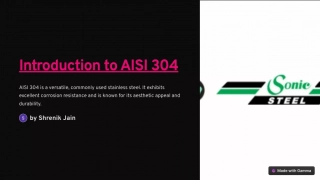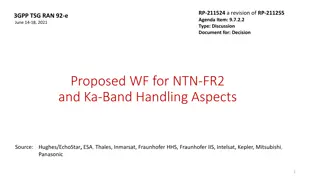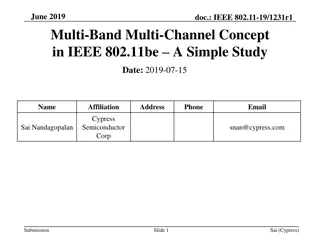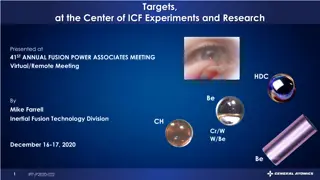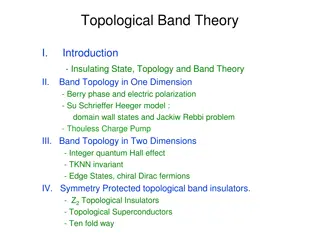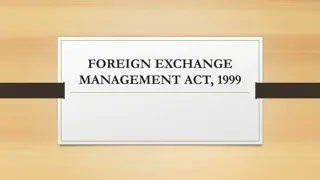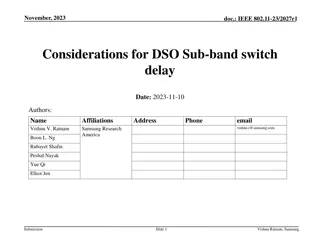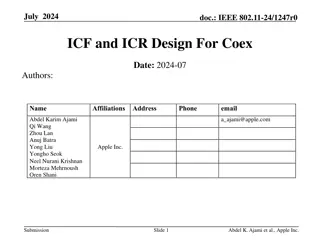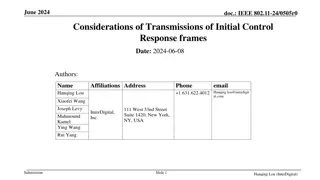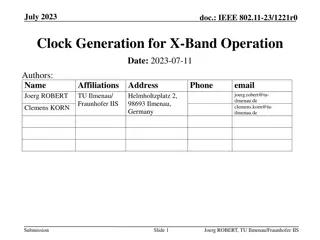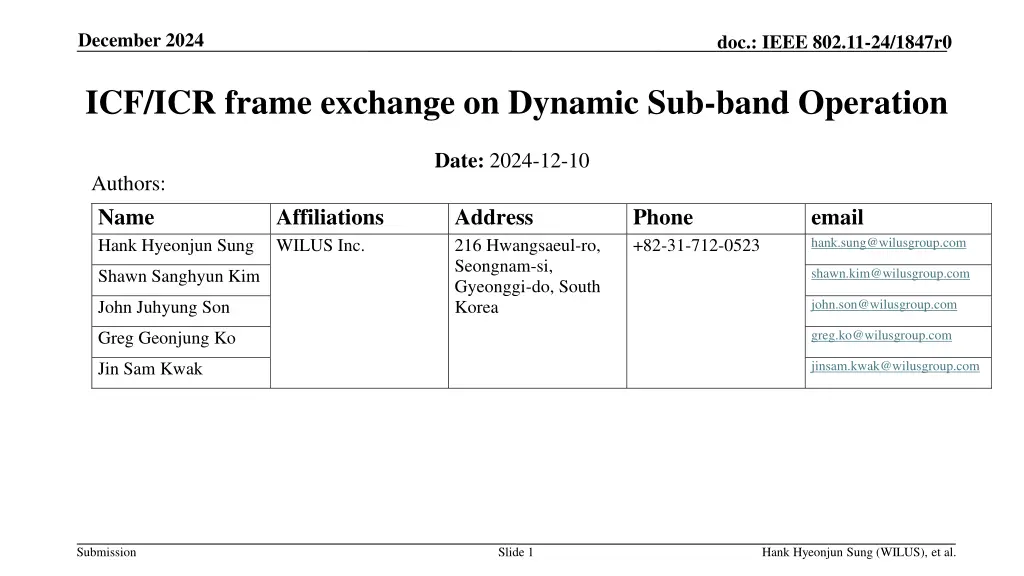
Dynamic Sub-band Operation in IEEE 802.11-24
Explore the challenges and proposals related to Dynamic Sub-band Operation (DSO) in IEEE 802.11-24. Discussions include issues with CFO requirements, channel switching difficulties, and residual errors. Learn about methods for APs to handle ICF/ICR frame exchange successfully in non-AP STA bandwidths.
Download Presentation

Please find below an Image/Link to download the presentation.
The content on the website is provided AS IS for your information and personal use only. It may not be sold, licensed, or shared on other websites without obtaining consent from the author. If you encounter any issues during the download, it is possible that the publisher has removed the file from their server.
You are allowed to download the files provided on this website for personal or commercial use, subject to the condition that they are used lawfully. All files are the property of their respective owners.
The content on the website is provided AS IS for your information and personal use only. It may not be sold, licensed, or shared on other websites without obtaining consent from the author.
E N D
Presentation Transcript
December 2024 doc.: IEEE 802.11-24/1847r0 ICF/ICR frame exchange on Dynamic Sub-band Operation Date: 2024-12-10 Authors: Name Hank Hyeonjun Sung Affiliations WILUS Inc. Address 216 Hwangsaeul-ro, Seongnam-si, Gyeonggi-do, South Korea Phone +82-31-712-0523 email hank.sung@wilusgroup.com shawn.kim@wilusgroup.com Shawn Sanghyun Kim john.son@wilusgroup.com John Juhyung Son greg.ko@wilusgroup.com Greg Geonjung Ko jinsam.kwak@wilusgroup.com Jin Sam Kwak Submission Slide 1 Hank Hyeonjun Sung (WILUS), et al.
December 2024 doc.: IEEE 802.11-24/1847r0 Introduction Many contributions about DSO have been discussed in TGbn [2-18] DSO allows an AP to allocate RUs outside of a non-AP STA s operating bandwidth [2] Some contributions discussed the difficulty of switching channel outside of a non-AP STA s operating bandwidth during the DSO ICF/ICR frame exchange [8][11][13][17] Switching delay [11] Calibration for new operating channel [8] [13] [17] Residual CFO error [8] In this contribution, we discuss an issue on CFO requirement during the DSO ICF/ICR frame exchange and propose methods for an AP to decode the ICR or to determine that the ICR on the DSO sub-band has been successfully received Submission Slide 2 Hank Hyeonjun Sung (WILUS), et al.
December 2024 doc.: IEEE 802.11-24/1847r0 Recap: Pre-correction accuracy requirement in 11be [1] A STA compensates for CFO error and symbol clock error with respect to the corresponding triggering PPDU when transmitting the following types of PPDUs: (HE/EHT/UHR) TB PPDU The non-HT (dup) PPDU with the TXVECTOR parameter TRIGGER_RESPONDING set to true After compensation, the absolute value of residual CFO error with respect to the corresponding triggering PPDU shall not exceed the following levels when measured at the 10% point of the CCDF of CFO errors in AWGN at a received power of -60 dBm in the P20 channel 350 Hz for the data subcarriers of a TB PPDU (Triggering frame/TB PPDU response) 2000 Hz for a non-HT (dup) PPDU (MU-RTS/CTS frame exchange) Submission Slide 3 Hank Hyeonjun Sung (WILUS), et al.
December 2024 doc.: IEEE 802.11-24/1847r0 Recap: Experiment about CFO versus. channel switch [8] The experiments in [8] demonstrated an estimation of the change in CFO when the operating channel switches (20/ 80/ 160) MHz within the 5GHz band As a result, when the channel switch involves 80MHz or more, the change in CFO can exceed 350 Hz requirement of 11be: 80 MHz channel switch incurs ~500 Hz CFO error 160 MHz channel switch incurs ~1000 Hz CFO error The changes in CFO cannot be reliably predicted or calibrated out: The CFO changes may vary over time, making calibration challenging or impractical in some implementations. Submission Slide 4 Hank Hyeonjun Sung (WILUS), et al.
December 2024 doc.: IEEE 802.11-24/1847r0 CFO issue on the DSO ICF/ICR frame exchange The DSO non-AP STA is required to respond with a TB PPDU including the ICR on the DSO sub-band. However: The DSO non-AP STA has not obtained information about the extent of the CFO with the AP after switching to the DSO sub-band (difficult to compensate the residual CFO error) When the DSO non-AP STA transmits a TB PPDU with the ICR on the DSO sub-band, the residual CFO error of the TB PPDU may exceed the acceptable threshold at the AP side not meeting the baseline requirements. DSO STA 2 DSO sub-band The expected PPDU reception by AP Padding DSO STA 1 DSO ICF (BSRP) The PPDU actually sent by DSO STA 2 DSO STA 2 ICR from Primary sub-band Primary sub-band Submission Slide 5 Hank Hyeonjun Sung (WILUS), et al.
December 2024 doc.: IEEE 802.11-24/1847r0 CFO issue on the DSO ICF/ICR frame exchange Challenges: Due to CFO, the TB PPDU including the ICR transmitted by the DSO non-AP STA may not be properly decoded by the AP leading to high Packet Error Rate (PER). If the AP cannot decode the ICR, it may infer that the DSO non-AP STA is not ready to operate on the DSO sub-band, leading to the exclusion of the STA from subsequent frame exchange sequences. Proposals: 1. Limited MCS for the DSO ICR to decode successfully: A mechanism for the AP to reduce the decoding errors, improving ICR decoding reliability. 2. Criteria for the AP to determine the reception of the ICR on the DSO sub-band A method for the AP to determine whether the DSO non-AP STA has transmitted the ICR at the allocated RU on the DSO sub-band, irrespective of CFO issues. Submission Slide 6 Hank Hyeonjun Sung (WILUS), et al.
December 2024 doc.: IEEE 802.11-24/1847r0 1. Limited MCS for the DSO ICR Transmitting at a high MCS PPDU without prior knowledge of the DSO sub-band information can lead to an increased PER at the AP. The DSO non-AP STA cannot accurately assess the extent of its CFO on the DSO sub- band, contributing to high PER of the ICR at the AP. Proposal: To reduce the PER for ICR, a limited and robust MCS should be used for transmission. Choose an MCS capable of ensuring the AP can decode the TB PPDU from the DSO sub-band, even if the CFO requirement is not met. Similar to using a low MCS (e.g., MCS 0 [20]) for transmitting CTS frames in RTS/CTS frame exchanges, a low MCS can be applied for transmitting the TB PPDU containing the ICR on the DSO sub-band. Submission Slide 7 Hank Hyeonjun Sung (WILUS), et al.
December 2024 doc.: IEEE 802.11-24/1847r0 2. Criteria for AP to determine the reception of the DSO ICR The AP determines that the DSO non-AP STA has successfully switched to the DSO sub-band if the AP detects the PHY preamble of the TB PPDU, regardless of whether the MAC frame was successfully decoded. If the PHY preamble of the TB PPDU is detected on the allocated RU, the AP considers the corresponding DSO non-AP STA is eligible to participate in the next frame exchange sequence. (3) The AP determines the DSO STA 3 is ready to operate on the DSO sub-band and allocates the RU for DSO STA 3 (2) Only PHY preamble detection occurs on the RU allocated to DSO STA 3 (4) (4) DSO STA 4 DSO STA 4 or Triggering frame (3) The DSO STAs can estimate the CFO using previous received PPDU and transmit the response with meeting the CFO requirement DSO sub-band (2) DSO STA 3 DL MU PPDU (1) DSO STA 2 DSO STA 2 DSO ICF (BSRP) DSO STA 1 DSO STA 1 (1) The AP allocates RU to DSO STA 1,2, 3, 4 on the DSO sub-band ICR from primary sub-band Response from primary sub-band Primary sub-band SIFS SIFS SIFS Submission Slide 8 Hank Hyeonjun Sung (WILUS), et al.
December 2024 doc.: IEEE 802.11-24/1847r0 Summary The CFO issue on the DSO ICF/ICR frame exchange were discussed. After moved to the DSO sub-band, the DSO non-AP STA may not be possible to meet the CFO requirement for the TB PPDU including the ICR without proper channel information Without successfully decoding the ICR, the DSO AP cannot ensure whether the DSO non- AP STA has switched to the DSO sub-band We proposed the methods for supporting the DSO ICF/ICR frame exchange under residual CFO error Apply the robust MCS for ICR transmission Consider the successful PHY preamble reception as the successful ICR frame reception Submission Slide 9 Hank Hyeonjun Sung (WILUS), et al.
December 2024 doc.: IEEE 802.11-24/1847r0 References [1] Draft P802.11be_D7.0 [2] 11-22/2204 Dynamic Subband Operation Sindhu Verma [3] 11-23/0843 Considerations on Dynamic Subband Operation Liuming Lu [4] 11-23/1496 EMLSR Dynamic Subband Operation Yongho Seok [5] 11-23/1892 Thoughts on Dynamic Subchannel Operation Gaurang Naik [6] 11-23/2027 Considerations for DSO sub-band Switch Delay Vishnu V. Ratman [7] 11-23/2141 Further discussion on Dynamic Subband Operation Sindhu Verma [8] 11-24/0299 Initial Control Frame for Bandwidth Switching mode Vishnu V. Ratman [9] 11-24/0449 Considerations on Dynamic Subchannel Operation follow up Liuming Lu [10] 11-24/0493 Dynamic Channel Switch Operation Liwen Chu [11] 11-24/0517 Preallocation of Subband for DSO follow up Vishnu V. Ratman [12] 11-24/0591 EMLSR Secondary Channel Operation Zhou Lan [13] 11-24/1474 Some thoughts on Dynamic Sub-band Operation Li Quan [14] 11-24/1553 DSO follow up Gaurang Naik [15] 11-24/1564 DSO follow up Liwen Chu [16] 11-24/1587 Discussion on DSO operation Kaiying Lu [17] 11-24/1588 DSO configuration Shubhodeep Adhikari [18] 11-24/1589 Dynamic Subband Operation, follow up Morteza Mehrnoush [19] 11-24/1542 Sounding schemes for coordinated beamforming Sameer Vermani [20] 11-24/1573 An ELR PPDU Follow Up Wookbong Lee Submission Slide 10 Hank Hyeonjun Sung (WILUS), et al.
December 2024 doc.: IEEE 802.11-24/1847r0 Straw Poll 1 Do you agree to add the following text to the 11bn SFD? The MCS(s) values for the the ICR transmitted by the DSO non-AP STA are limited to TBD values. Submission Slide 11 Hank Hyeonjun Sung (WILUS), et al.
December 2024 doc.: IEEE 802.11-24/1847r0 Straw Poll 2 Do you agree to add the following text to the 11bn SFD? After transmitting an ICR for DSO, if the AP correctly decodes the UHR PHY preamble on a 20MHz channel, the AP may consider the non-AP STA, which was scheduled to transmit the ICR including that 20MHz channel as having successfully switched its operating bandwidth to the DSO sub-band. Submission Slide 12 Hank Hyeonjun Sung (WILUS), et al.

